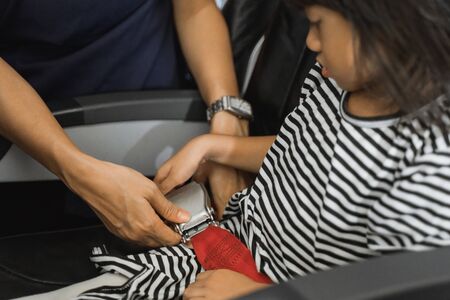1. Understanding Car Seat Safety Standards in the U.S.
When it comes to keeping your child safe on the road, understanding car seat safety standards in the United States is essential. With so many options available, American parents need to know what makes a car seat truly safe and which guidelines to follow. Here’s a simple breakdown to help you make confident choices as you explore “The Best Car Seats for Different Age Groups.”
Overview of Federal Guidelines
In the U.S., car seat safety is regulated by federal standards set by the National Highway Traffic Safety Administration (NHTSA). All car seats sold must meet strict requirements for crash protection, labeling, and instructions. Key points include:
- Federal Motor Vehicle Safety Standard 213 (FMVSS 213): Sets minimum safety requirements for car seats used in passenger vehicles.
- Labeling: Car seats must have labels with weight and height limits, manufacturing date, and expiration date.
- Instructions: Manufacturers are required to provide clear installation and usage instructions.
Car Seat Stages According to Age & Size
| Stage | Recommended Age/Weight | Type of Car Seat |
|---|---|---|
| Rear-Facing | Birth to 2-4 years (up to highest weight/height allowed by seat) |
Infant Car Seat or Convertible Car Seat (rear-facing) |
| Forward-Facing | Around 2-7 years (up to highest weight/height allowed by seat) |
Convertible or Combination Seat (forward-facing with harness) |
| Booster Seat | Around 5-12 years (until seat belt fits properly) |
Belt-Positioning Booster Seat |
| Seat Belt Alone | 8-12 years and up (when adult seat belt fits correctly) |
Vehicle’s Built-in Seat Belt |
The Latest Safety Ratings: What Matters Most?
The NHTSA conducts annual car seat ratings based on ease of use, installation, and overall safety features. When shopping, look for:
- NHTSA Ease-of-Use Ratings: Helps parents find seats that are simple to install and adjust correctly.
- Consumer Reports: Offers independent crash test results and user reviews from other American parents.
- LATCH System Compatibility: Most new vehicles and car seats support Lower Anchors and Tethers for Children (LATCH) for safer installation.
NHTSA Ease-of-Use Rating Levels
| Rating Level | Description |
|---|---|
| ★★★★ | Easiest to use; clear instructions and labels; simple installation. |
| ★★★ | Good; minor issues with clarity or installation steps. |
| ★★ | Adequate; some difficulties but meets basic requirements. |
| ★ | Difficult to use; may lead to misuse or incorrect installation. |
Key Points Every American Parent Should Know
- Expiration Dates Matter: Car seats have expiration dates (usually 6–10 years after manufacture) due to wear, tear, and evolving safety standards.
- No Secondhand Surprises: Avoid buying used car seats unless you know their history — past accidents or missing parts can compromise safety.
- No Coats Under Harnesses: Bulky clothing can prevent harness straps from fitting snugly; dress children in thin layers when riding in the car seat.
- Register Your Car Seat: Always register your new car seat with the manufacturer to receive important recall updates.
- Tether Use Is Important: When forward-facing, always use the top tether strap for extra head and neck protection during a crash.
- The Back Seat Is Safest: Children under 13 should always ride in the back seat — it’s the safest place in case of an accident.
Your Child’s Safety Starts with Knowledge
Selecting the right car seat isn’t just about age—it’s about matching your child’s weight, height, and developmental stage with current U.S. standards. The next sections will guide you through choosing the best car seats for each age group, ensuring every ride is as safe as possible for your family.
2. Top Infant Car Seats: Comfort, Safety, and Convenience
Choosing the right infant car seat is one of the most important decisions you’ll make as a new parent. With so many options on the market, it can feel overwhelming to pick the best one for your baby. In the United States, parents look for car seats that combine safety, comfort, and convenience—especially those that are easy to install and portable for on-the-go lifestyles.
What Makes a Great Infant Car Seat?
- Safety: Meets or exceeds federal safety standards and features side-impact protection.
- Portability: Lightweight design makes it easier to carry your baby from the car to the stroller or into your home.
- Ease of Installation: Simple latch systems or clear seatbelt paths help reduce installation errors.
- Comfort: Plush padding, adjustable harnesses, and newborn inserts keep your baby snug and supported.
- Compatibility: Many top models easily click into compatible strollers, making travel seamless.
Top-Rated Infant Car Seats in the U.S.
Here’s a quick comparison of some of the most popular infant car seats among American parents:
| Model | Main Features | Weight Limit | Approximate Price Range |
|---|---|---|---|
| Chicco KeyFit 30 | Super easy install, excellent safety ratings, fits smaller cars | 4-30 lbs | $200-$230 |
| Nuna PIPA RX | Lightweight, chemical-free fabrics, dream drape canopy | 4-32 lbs | $350-$400 |
| Graco SnugRide SnugLock 35 | User-friendly base with click connect technology, budget-friendly | 4-35 lbs | $120-$180 |
| Cybex Aton 2 SensorSafe | Sensors alert caregivers if baby is left in car, compact size | 4-35 lbs | $250-$300 |
| UPPAbaby MESA V2 | No-rethread harness, easy-to-read indicators, integrates with Vista stroller system | 4-35 lbs | $330-$370 |
Key Considerations for American Parents
- Lifestyle Needs: If you often use ride-shares or switch cars frequently, look for a model with easy installation and lightweight portability.
- Weather Protection: Features like extra-large canopies are great for sunny or rainy climates.
- LATCH Compatibility: Most newer vehicles in the U.S. are equipped with LATCH anchors—make sure your chosen seat works seamlessly with your car.
- Avoiding Common Mistakes: Always double-check installation guides and register your car seat for safety recalls.
The Bottom Line on Infant Car Seats (for This Section)
The best infant car seats offer a blend of safety, comfort, and user-friendly features designed to make life easier for busy American families. By focusing on trusted brands and checking key features like installation ease and compatibility with your lifestyle, you can confidently choose a seat that keeps your newborn safe wherever you go.

3. Best Convertible Car Seats for Growing Toddlers
As your little one transitions from infancy to toddlerhood, their car seat needs change. Convertible car seats are a smart investment for American families because they can be used both rear-facing for infants and forward-facing for toddlers. This means you get more mileage out of one seat, making it a budget-friendly and convenient choice.
Why Choose a Convertible Car Seat?
Convertible car seats adapt as your child grows. They start as rear-facing for babies and then convert to forward-facing when your child is ready. Many models offer extended weight and height limits, so your toddler stays safer, longer.
Top Features to Look For
- Extended rear-facing limits: For added safety during early years
- Easy installation: LATCH systems or simple belt paths
- Adjustable harness and headrest: Grows with your child
- Machine-washable covers: For those inevitable messes
- Cup holders and comfort padding: Keeps kids happy on the go
Top-Rated Convertible Car Seats in the U.S.
| Car Seat Model | Rear-Facing Weight Limit | Forward-Facing Weight Limit | Main Features | Why Parents Love It |
|---|---|---|---|---|
| Graco 4Ever DLX 4-in-1 | 4–40 lbs | 22–65 lbs (booster up to 120 lbs) | 10-year lifespan, easy install, machine-washable cover | Super versatile, lasts through all stages, great value |
| Britax One4Life ClickTight | 5–50 lbs | 22–65 lbs (booster up to 120 lbs) | ClickTight installation, steel frame, cool flow fabric options | Simple installation, sturdy build, comfy for long rides |
| Nuna RAVA | 5–50 lbs | 25–65 lbs | No-rethread harness, flame-resistant materials without added chemicals, compact fit for smaller cars | User-friendly design, high-quality materials, fits well in most vehicles |
| Evenflo Symphony Elite All-In-One | 5–40 lbs | 22–65 lbs (booster up to 110 lbs) | SureLATCH system, multi-position recline, integrated cup holders | Quick installation, comfortable padding, budget-friendly option |
| Diono Radian 3RXT Safe+ | 5–50 lbs | 22–65 lbs (booster up to 120 lbs) | Narrow design for three-across seating, folds flat for travel, reinforced steel core | Great for large families or smaller cars, travel friendly, very durable |
A Few Tips for Parents Shopping Convertible Car Seats:
- Check your vehicle’s compatibility: Some seats fit better in certain cars; always test before buying if possible.
- Pays off over time: A higher upfront cost can mean years of safe rides.
- Pediatricians recommend rear-facing as long as possible: Look for models with high rear-facing weight/height limits.
The Bottom Line on Convertible Car Seats for Toddlers:
A good convertible car seat makes travel easier and safer for both you and your growing toddler. With so many highly-rated options available in the U.S., you can find one that fits your family’s needs and budget—ensuring peace of mind on every ride.
4. Harness-to-Booster Seats: Trusted Picks for Preschoolers
As your child grows out of their convertible car seat but isn’t quite ready for a regular booster, harness-to-booster seats are the perfect solution. These seats are designed for preschoolers and young kids who still need the security of a 5-point harness but will soon be ready to transition to booster mode. Choosing the right harness-to-booster seat means focusing on safety, comfort, and ease of use.
What Is a Harness-to-Booster Seat?
A harness-to-booster seat, sometimes called a combination seat, starts out with a 5-point harness just like a forward-facing car seat. Once your child outgrows the harness (usually by height or weight), you can remove it and use the seat as a belt-positioning booster with your car’s seatbelt. This type of seat helps bridge the gap between toddler and big kid stages.
Key Features to Look For
- Adjustable 5-Point Harness: Offers maximum protection for younger children who aren’t ready for just a seatbelt.
- Easy Transition: Simple process to switch from harness mode to booster mode as your child grows.
- LATCH System Compatibility: Makes installation easier and more secure in many vehicles.
- Cushioned Padding & Head Support: Keeps kids comfortable during longer rides.
- Removable Covers: For quick cleaning—important for busy families!
Top Harness-to-Booster Seats Recommended by Parents
| Model | Weight Limit (Harness/Booster) | Main Features | User-Friendly Perks |
|---|---|---|---|
| Graco Tranzitions 3-in-1 | 22–65 lbs / up to 100 lbs | Narrow design, three modes (harness, highback booster, backless booster) | Cup holders, machine-washable cover |
| Britax Grow With You ClickTight | 25–65 lbs / up to 120 lbs | ClickTight easy installation, strong steel frame | Padded armrests, multiple recline positions |
| Evenflo Maestro Sport | 22–50 lbs / up to 110 lbs | Budget-friendly, lightweight design | Dual cup holders, simple harness adjustment |
| Diono Radian 3RXT SafePlus | 22–65 lbs / up to 120 lbs | Slim fit for three-across seating, reinforced side impact protection | Folds flat for travel, extended rear-facing option |
When Is Your Child Ready to Switch?
Your child should stay in the harness as long as possible—until they reach the maximum weight or height limit listed in your seat’s manual. When they’re ready, switching to booster mode is usually as simple as removing the harness and adjusting the headrest so that your vehicle’s seatbelt fits properly across their shoulder and lap.
Pro Tip: Always Check State Laws and Recommendations!
Laws about car seats vary by state in the U.S., so make sure you know your local requirements. The American Academy of Pediatrics recommends using a harness as long as possible before transitioning to a booster.
5. Top Booster Seats for Big Kids
When your child outgrows their forward-facing car seat with a harness, its time to switch to a booster seat. Booster seats are designed for school-aged children, usually between 4 and 12 years old, and help position the vehicle’s seat belt correctly on your child’s body. Choosing the right booster is essential for safety, comfort, and convenience—especially if your family carpools or travels often.
Why Booster Seats Matter for Big Kids
Booster seats lift your child so that the car’s lap and shoulder belts fit properly: the lap belt lies flat across the upper thighs, and the shoulder belt crosses the chest and shoulder (not the neck or face). Without a booster, adult seat belts can cause serious injuries in a crash.
Top Features to Look for in a Booster Seat
- Safety Ratings: Check for federal safety standards (FMVSS 213) and independent ratings from groups like the IIHS.
- Comfort: Look for cushioned seats, adjustable headrests, and padded armrests to keep kids comfortable on longer rides.
- Easy Installation: LATCH connectors can make installation quicker and more secure.
- Portability: If you switch cars often or carpool, lightweight boosters are easier to move around.
- Cup Holders & Storage: Handy for snacks and drinks during road trips or after-school activities.
Best Booster Seats for School-Aged Kids
| Booster Seat | Type | Main Features | Best For |
|---|---|---|---|
| Graco TurboBooster Highback | Highback/Backless | Padded, converts to backless, easy-to-adjust headrest | Everyday use & growing kids |
| Britax Skyline 2-Stage Booster | Highback/Backless | LATCH system, deep side impact protection, two cup holders | Safety-focused families & frequent travelers |
| Clek Oobr | Highback/Backless | Sleek design, rigid LATCH, reclines for naps | Long road trips & style-conscious parents |
| BubbleBum Inflatable Booster | Backless | Super lightweight, portable, fits three across easily | Carpooling & travel (taxis/rentals) |
| Diono Monterey XT | Highback/Backless | Expandable width, adjustable height, sturdy construction | Taller/bigger kids & growing families |
Tips for Using Booster Seats in Carpools and Travel
- Labeled with your childs name: When sharing rides with friends or neighbors, label your booster to avoid mix-ups.
- Choose easy-to-carry options: Lightweight or foldable boosters are great for switching between vehicles.
- Packing for flights: Some boosters (like BubbleBum) fit easily into carry-on luggage—perfect for vacation rentals or rideshares.
- Sit properly every ride: Remind kids that they must sit upright with the seatbelt positioned correctly at all times.
- No booster before theyre ready: Don’t rush to ditch the booster—kids should use one until they reach at least 4’9” tall (usually ages 10–12).
The Bottom Line on Boosters for Big Kids
The right booster seat keeps your big kid safe and comfortable while making life easier when you’re juggling carpools or family trips. Choose a model that fits both your child’s needs and your lifestyle—because safety never goes out of style!
6. Essential Tips for Installation and Maintenance
How to Properly Install Your Child’s Car Seat
Making sure your child’s car seat is installed correctly is crucial for safety. Even the best car seat won’t protect your child if it isn’t used properly. Here are some key steps:
- Read the manual: Always review both your car seat’s instruction manual and your vehicle’s owner manual for specific installation guidance.
- Choose the right spot: The safest place for a car seat is typically the back seat, away from airbags.
- Use the right method: Most seats can be installed with either the LATCH system or a seat belt—never use both at once unless the manufacturer says it’s okay.
- Tighten everything: The seat shouldn’t move more than an inch side-to-side or front-to-back once installed.
- Check the angle: For rear-facing seats, make sure the recline angle is correct to keep your baby’s head from slumping forward.
Routine Maintenance Checklist
Keeping your child’s car seat clean and in good condition ensures ongoing safety and comfort. Here’s a simple maintenance checklist you can follow:
| Task | How Often | Tips |
|---|---|---|
| Check harness and buckles | Weekly | Look for twists, frays, or dirt that may affect function. |
| Clean cover and straps | Monthly or as needed | Follow manufacturer instructions; never bleach straps. |
| Inspect seat for cracks or damage | Every few months | If you see any damage, replace the seat immediately. |
| Confirm tightness of installation | Each time you use it | The base should not move more than one inch in any direction. |
| Check expiration date | Annually | Car seats usually expire 6-10 years from manufacture date. |
When to Upgrade to the Next Car Seat Stage
Your child will need different types of car seats as they grow. Here’s when parents should consider making the switch:
| Current Seat Type | Signs It’s Time to Upgrade | Next Step |
|---|---|---|
| Infant Rear-Facing Seat> | Your child exceeds height or weight limit; head is less than 1 inch from top of shell.> | Convertible or All-in-One (rear-facing)> |
| Convertible Rear-Facing Seat> | Your child reaches max rear-facing height or weight (usually 40–50 lbs).> | Convertible Forward-Facing with Harness> |
| Forward-Facing Harness Seat> | Your child outgrows harness by height or weight.> | Belt-Positioning Booster Seat> |
| Booster Seat> | Your child fits vehicle lap/shoulder belt properly (typically age 8–12).> | No booster needed; use adult seat belt only.> |
A Few Extra Installation Tips Just for Parents in the U.S.>
- The American Academy of Pediatrics recommends keeping children rear-facing as long as possible—don’t rush to turn them around just because they’ve had a birthday!>
- If you’re unsure about your installation, many local fire departments and hospitals offer free car seat checks.>
- Avoid using secondhand seats if you don’t know their history—they might have been in a crash or recalled.>


